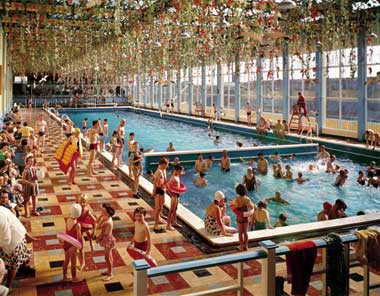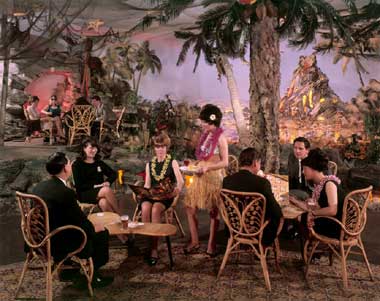 |
David Noble: BUTLINLAND SKEGNESS Night Scene; courtesy the Gallery of Photography, copyright John Hinde Ltd. |
This latest exhibition in the Gallery of Photography shows work that is a curious hybrid of social and cultural history, photographic documentary, advertisting and popular culture. The photographs on display were produced in the late 1960s and early 1970s for the John Hinde Photography studio in Dublin, comprising part of a series of postcards to be sold at Butlin’s holiday camps throughout Britain and Ireland. Shot with large-format cameras, and lit like a film set, the production of these photographs was an extraordinary undertaking: the pieces seen in the exhibition, mostly only published as postcards, have been reproduced from the original large-format Ektachromes for this show.
With innovative use of colour and elaborate staging (the trademarks of a John Hinde postcard), it has been observed how Hinde’s meticulous approach to structuring images was akin to the methods and motives of the advertising profession who aimed to play on the emotions of a mass audience (all of whom were potential tourists with the arrival of such holiday camps as Butlin’s, the “proletariat paradise" 1 ). With the Hindesight exhibition at IMMA in 1993, he began to be acknowledged as an important figure in the social history of photography (this exhibition showed his best-known work, the stereotypical images of 1950s Ireland that are embedded in the public consciousness: they aimed to evoke a collective nostalgia for an Ireland that never fully existed anywhere other than the imagination. Images of redhaired children with a turf-carrying donkey and a six-legged currach walking down the beach are two of the most emblematic of the Hinde house style, and the work in this exhibition is a similar rendition of such idealised dream worlds/tourist destinations).
 |
Elmar Ludwig: BUTLIN’S MOSNEY The Indoor Heated Pool; Courtesy the Gallery of Photography, copyright John Hinde Ltd. |
It was the challenging job of two German and one British photographer (Elmar Ludwig, Edmund Nagele and David Noble) to execute the Butlin’s photographs to Hinde’s rigorous formula and standards, creating images that look casually taken but were actually acutely observed and involved the orchestration of large crowds, cameras and systems of lighting. The various photographic contexts on display, from Mosney, Co. Meath, to Skegness and Bognor Regis were all tightly controlled, frequently using large casts of real-life holidaymakers acting out their allocated roles. Narrative tableaux are enacted in quiet lounges, busy cabarets, restaurants, swimming pools and ballrooms, environments which are as self-consciously constructed and decorated as the images themselves.
 |
Edmund Nagele: BUTLIN’S BOGNOR REGIS A Corner of the Beachcomber Bar; Courtesy the Gallery of Photography, copyright John Hinde Ltd. |
Lush with detail and saturated with colour and pattern, the photographs’ surfaces are as glossy and tempting as boiled sweets (with some of the attendant connotations of sickliness that accompany such visual excess). The lurid colour tends to emphasise their fantastical nature. Laden with patterns, the over-decorated and out-dated interiors and fashions make for seductively ironic and easily consumable images: they are a feast of kitsch to be gorged upon. One image, for example, depicts the Beachcomber Bar: a waitress is dressed in a grass skirt and lei and fake fishnets and starfish adorn the ceiling – it is images like these that have acquired a funny kind of cult status and illustrate the simulational nature of tourism (prefiguring today’s safari parks and other ‘themed’ holiday and leisure environments).
Anticipating the later success of Disney and other recreational theme parks, Butlin’s was in its heyday at the time these images were taken, its ‘hi-de-hi’ redcoat entertainment the epitome of family holiday fun (and camp, though the latter in retrospect). The Butlin’s represented by these photographs is intricately bound up with the history of mass tourism, mass consumerism and popular culture in the British Isles: ‘cheap and cheerful’ low-brow entertainment and affordable packages attracted over a million people for a week’s holiday each year from the 1950s through the 1970s. As cultural documents, these images portray the working classes/masses on holiday, and in all the images the markers of class and how it is inscribed on the body (clothes, hairstyles, postures) are evident. The exhibition is itself all to do with ideas of taste, both in terms of its content, and the process of curatorship.
The images call to mind the contemporary work of British photographer Martin Parr, who curated the exhibition. He is well known for his striking documentation of popular culture and the banality of the everyday: one specific series he produced, entitled New Brighton, portrayed the decline of the popular holiday resort (and the working classes) in Thatcher’s England. He is also known for being a compulsive collector of kitsch, including seaside and holiday postcards such as Hinde’s, and even his photographic style of saturating the image with colour and so ‘flattening’ it (achieved through use of strong flash) is reminiscent of the work on show. The exhibition can be seen as part of the current trend in contemporary art that recognises the inherent subjectivity invested in the role of curator and the interdisciplinary nature of contemporary art practice (collaborations between artists and curators, and the blurring of these distinctions, are becoming increasingly common – artist Rirkrit Tiravanija recently curated a section of the Venice Biennale, and in Ireland artist Sarah Pierce has worked on the Metropolitan Complex Project and as curatorial editor on the Sculptors’ Society’s new publication, Printed Project ). One can thus envisage the exhibition as a segment not just of a historical archive, but also a personal one; an indicator of a particular eye and personal taste.
These images helped John Hinde become one of the most successful postcard publishers in the world, and seem to deftly encapsulate the look, attitudes (possibly even values) of a particular time in the evolution of cultural taste and consumerism. Images of an idealised world apart, isolated from their time and original commercial context, they are incredibly striking and unexpectedly poignant.
Sarah Browne is an artist and writer currently based in Dublin.
1 John Kindness, Trick or Treat? Different perspectives on Hindesight, the John Hinde exhibition at IMMA, CIRCA 65, 1993, pp.45.
OUR TRUE INTENT IS ALL FOR YOUR DELIGHT, The John Hinde Butlin’s Photographs, Gallery of Photography, Dublin. December 6, 2003 – January 31, 2004. Curated by Martin Parr. Produced by Chris Boot. In Association with Les Rencontres d’Arles.
Accompanying Book: OUR TRUE INTENT IS ALL FOR YOUR DELIGHT, The John Hinde Butlin’s Photographs, introduced by Martin Parr, published in UK/Europe by Chris Boot, May 2003. ISBN 0-9542813-0-6. Price 39.95 euro.